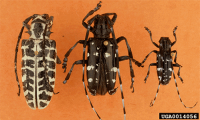
Origin
Asian longhorned beetle, Anoplophora glabripennis Motschulsky, is native to Asia (principally China) and invasive in parts of western Europe, and in several American cities, where eradication efforts are underway. This borer attacks a variety of hardwood trees.
Spread
In China, Asian longhorned beetles are not damaging in forests, but because of extensive planting of certain poplars (exotic varieties) that proved highly susceptible to the species, the insect increased in abundance. This action facilitated the beetle's dissemination to other countries because infested wood was used for packing material.
Ecological Threat
In southern Asia, a generation requires one year, but in northern areas, two years are required. Generations may be overlapping. Unlike many cerambycids, A. glabripennis attacks healthy trees as well as those under stress. Several generations can develop within an individual tree, eventually killing it.
Adults
Adults emerge over an extended period from spring to fall, but especially in late June to early July. Adults remain on or near their emergence tree and engage in maturation feeding on leaves, petioles, and tender bark. Eggs are laid singly under the bark, in egg sites chewed by females.
Larvae
Larvae feed in the cambium layer of the tree and later into the heartwood. Larvae dig pupation chambers inside the tree, which can be filled with frass. Adults emerge via large (0.4 in. [1 cm] dia) round exit holes, which are a visible sign of infestation.
(For more information please visit: https://www.invasive.org/browse/subinfo.cfm?sub=2178)


